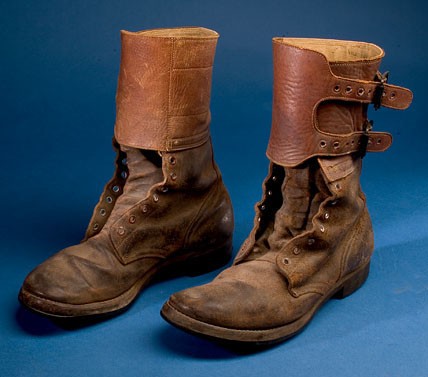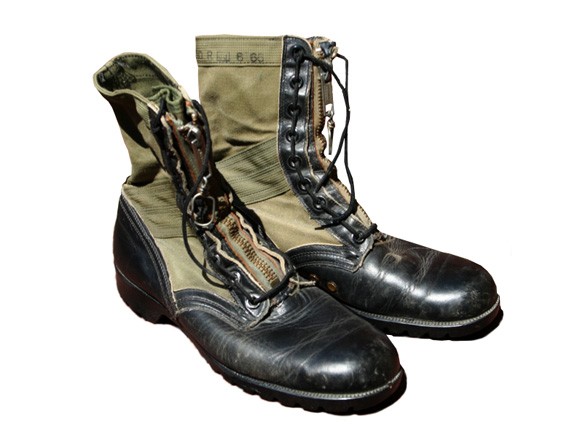
Military footwear can be traced back over thousands of years, even as far back as the Roman Empire, and just like humans, the combat boot has evolved through generations of change and adaptation. Arguably one of the most important pieces of equipment or gear anyone in a combat situation may possess, the combat boot has come a long way from its humble beginnings.
Several important military traditions were given birth to during the historic break from England in 1770's. The U.S. was still young, and its military was tiny compared to England’s oppressive command. Smaller militias lent aid to the cause from all across the original colonies, most of which had their own distinct colours and apparel, alluding to the different military divisions we know today. The typical dress worn would be - a hunting shirt, breeches, leggings, wool jacket, hat, and whatever footwear was available. Since raw materials were expensive, and taxes high, many soldiers, and even civilians, were forced to improvise with their footwear. In the colder colonies, where shoes were necessary to fight against frostbite and hypothermia, ground troops used whatever materials they had on hand. Scraps of cloth or raw animal hide were popular choices, but on occasion blankets tied to the feet would prove better than going barefoot into battle.
Cavalry, ranking officers, and those that could afford them typically wore Hessian boots. Hessian boots originated in Germany, and were knee high with a short heel, tailored for riding on horseback. The boots typically had tassels on the front, and were later cut lower in the back to help with manoeuvrability white still offering protection for the knee. The boots were styled for a close fit and worn with knee high breeches. Due to the tightness of this boot, a boot hook was often necessary to properly put the boots on, which proved a lengthy process.

Standardised boots were hard to come by during the 19th century, and much of the military still wore whatever shoes they were able to afford. Infantry units wore calf high riding boots in a style similar to the Hessian Boot. Trooper boots that went up past the thigh offered the most protection, but were expensive and impractical for ground units on long marches. The beginning of government issued boots came about in the War of 1812. The War Department ordered as many pairs of ankle high boots that were available to the at the time, and outfitted the soldiers that would need them the most. The boots were typically sewn on straight lasts, a type of shoe mold that made each shoe completely symmetrical. Until they were properly broken in the boots proved uncomfortable, often leaving blisters. Sometimes called Brogan boots, they were usually made of calfskin or patent leather.
One of the first revolutions in military footwear came about in 1837 when a 'pegging' machine was invented, this made for the faster production of cheap boots and booties. The pegs, usually small pieces of wood or metal, were used to hold the shape of the boot, but deteriorated much faster than the hand-sewn method. By the time the American Civil War came, the government reverted back to the original design of hand sewn boots. The price for pegged boots decreased to just over $1.25, while hand sewn Cavalry boots were often purchased at three times that price. The idea of soles became more popular during this time, and most were hand sewn. The Hessian boot was replaced by a Wellington style M1851 Artillery Driver’s boot, which were outfitted to cavalry and artillery drivers. The heel was slightly shorter than the Hessian boot, and the toe was more squared. In an effort to improve durability, brass tacks were inserted in the sole.
Union soldiers had access to better quality materials, while their Confederate counterparts suffered with boots of sub-par quality. The soldiers fighting for the North were first issued hand-sewn boots, and pegged boots only as a last resort. Most boots worn by the Confederate Army were pegged, nailed, or riveted, and fashioned in a style similar to that of the British Military at the time. Some of the greedier manufacturers used poor materials in an effort to take advantage of the civil turmoil. Rumours of cardboard being used circulated, and some even sharpened the pegs or brass tacks in the soles to make them wear out more quickly.
With the evolution of explosives and artillery like grenades and machine guns, trench-style warfare became more common during the early and mid-1900’s. Given the wet, cold, and unsanitary nature of the trenches, military gear and equipment, boots in particular, had to hold up against extreme conditions.

The modern combat boot we know today began to take shape in WWI. Most boots made in the early 1900’s had a distinct left and right, as opposed to previous versions with each shoe being virtually interchangeable. In the early years of WWI, the Russet Marching shoe was the most widely accepted boot worn in the military. It was highly polishable and made of machine-sewn calfskin. The inner lining was made from feathers. While this boot proved far more advanced than previous issue boots, it did not hold up well on French terrain. A later version, modelled with specifications from France and Belgium, was made from vegetable retanned cow hide, and featured both a full and half-sole. Rows of hobnails and iron plates were affixed to the heel of every boot. The heel and sole were attached with screws, nails, and stitching, and despite their superior construction, still did not hold up against the rough conditions.

In 1917 the Trench Boot was born, offering vast improvements from the Russet Marching Shoe. While it offered better protection against the wet conditions, it was not waterproof, which lead to various diseases like trench foot. The look and styling was similar to the marching shoe, but the insole was composed of new materials like; canvas, cork, and cement. Due to the rigid nature of the soles, the boots were highly uncomfortable until broken in and the natural movement of the foot caused excessive damage. The Trench Boot offered little in the way of insulation, and many soldiers complained of cold feet. It became common practice to wear multiple pairs of socks, and order boots a few sizes above what one would normally wear. Several different variations were produced in an attempt to fix the early issues of waterproofing.
A year later, the 1918 Trench Boot, or “Perishing Boot” was released, offering improvements over earlier versions. Better quality materials, such as heavier leather and stronger canvas were used in an attempt to improve the longevity of use. The boot’s soles were attached in a similar fashion with screws and nails, but held three soles in total, as opposed to the previous issue’s one and a half. The metals used in hobnailing conducted the cold, and the thicker sole helped eliminate that problem. Iron toe cleats were added to the toe of each boot, offering extra protection, but making the boots bulkier.

During the initial stages of WWII, the standard issue US military boot was the M-42 'Service Shoe', an all leather toe cap boot with a two piece stitched sole, this style was eventually replaced by the rough-out boot, probably the most recognisable boot of the war. After the Normandy invasion the American military started updating their equipment, one of the items they replaced was the canvas gaiters and rough out ankle boot. They did this by basically making the rough out boot higher by adding a double buckle leather gaiter onto the top of the boot. The M-43 buckle boots where in general issue by the winter of 1944/45 and where worn by all branches of service including the Paratroopers, Armoured and Infantry in the Battle of the Bulge. They were titled 'Boots, Combat Service', and nicknamed “Double Buckle Boots.” While previous military boots like the Trench Boots only had laces, these boots went back to the older buckle style. These boots were made from synthesised rubber and other recycled materials, and had a leather fold-over cuff with two buckles. With only a single sole, they proved uncomfortable, but much easier to move around in than the Trench Boot. In times of shortage, some units, particularly Rangers, were issued Paratrooper Jump boots, which were quite distinct from all other boots at the time. The Paratrooper boots were highly sought after by regular troops who often purloined or "acquired" via alternative means.

Previous issue boots with minimal variation were used during the Korean War, but were not fit for purpose in Vietnam. Vastly different climates and temperatures rapidly deteriorated the soles and integrity of the Combat Service Boot, which was eventually replaced by the Jungle Boot.
The general idea behind Jungle Boots first came about in Panama and the latter part of WWII for Soldiers serving in the Pacific. While these boots consisted mainly of rubber and nylon, they did not hold up well. The government issued boot was typically the traditional all leather combat boot, or the Jungle Boot. The U.S. Department of War tasked the company Wellco with solving the troops various issues with moisture, insects, and sand. Wellco created and sold a prototype which held up better than their previous counterparts. The boot was composed of a black leather sole and canvas upper with an attached tongue, which helped to keep out insects and debris. It built upon earlier generations by using rubber and a canvas with a cotton blend, but added in the durability of leather. Water drains were added to help keep the feet dry and prevent bacteria from growing.
After in-combat testing and feedback, the Jungle Boot was adapted to better suit the soldiers’ needs. The canvas blend was replaced with a nylon canvas that dried faster. Steel plates were affixed to the soles of the boot, to protect the feet against punji stakes used to pierce the foot. Additional nylon webbing reinforced the boots’ uppers, increasing the durability. While these boots did not last as long as all leather combat boots, they did offer a vast improvement over the earlier versions. Soldiers were known to carry multiple sets of boots, and often wore their jungle boots only when absolutely necessary. These high tech jungle boots signalled the dawn of a new era, over the next 20 years combat boots would evolve into the lightweight protective boots worn today.
While impossible to predict the future, it’s a safe bet that combat boots will continue to grow and evolve alongside those that wear them. From the Roman Empire to the sands of present day Iraq, it’s easy to forget that something we see regularly can have such a rich history. With huge leaps in all aspects of technology, who’s to say which direction the design and features of future boots will take.